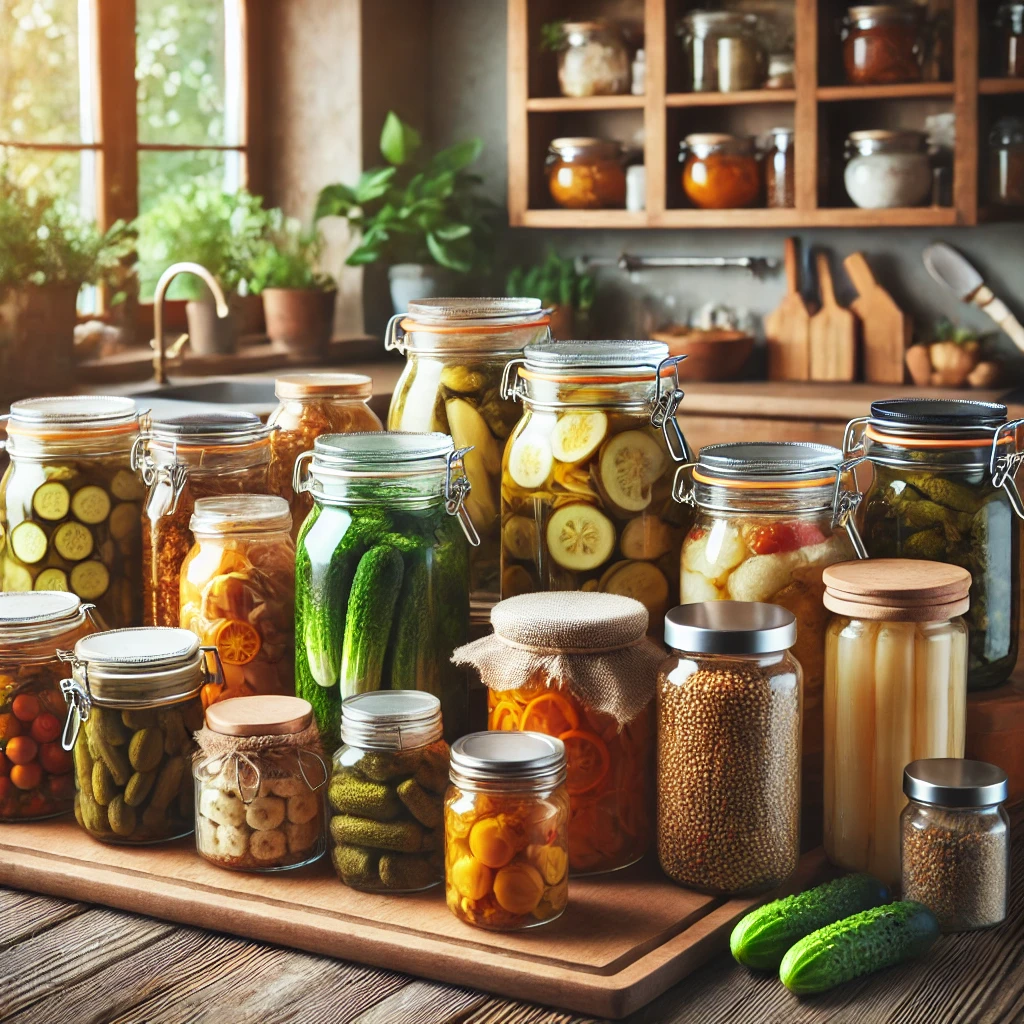Introduction: Food preservation has been an essential practice for centuries, allowing us to store seasonal produce and reduce food waste. Whether you want to enjoy your favorite fruits and vegetables year-round or extend the shelf life of meats and dairy, mastering basic food preservation techniques is key. In this blog, we’ll explore the fundamentals of food preservation, from traditional methods like pickling and fermenting to modern techniques like freezing and canning. These methods not only prevent spoilage but also enhance the flavor and nutritional value of many foods.
Popular Food Preservation Methods
- Pickling:
- What It Is: Pickling involves preserving food in an acidic solution, typically vinegar, which prevents bacteria growth. Commonly pickled items include cucumbers, onions, and carrots.
- How It Works: The acidity of vinegar creates an environment where harmful bacteria can’t survive, allowing food to stay fresh for months.
- Tip: Add spices like dill, mustard seeds, or garlic to your brine for extra flavor. Pickling is a quick and easy way to preserve vegetables while giving them a tangy bite.
- Fermenting:
- What It Is: Fermentation relies on natural bacteria to convert sugars into lactic acid, which acts as a preservative. Foods like kimchi, sauerkraut, and yogurt are all made through fermentation.
- How It Works: Lactic acid produced during fermentation preserves the food and enhances its flavor and nutritional value by introducing beneficial probiotics.
- Tip: Always ensure your fermenting environment is clean to avoid unwanted bacteria. Fermented foods often develop deeper, more complex flavors over time.
- Canning:
- What It Is: Canning involves sealing food in jars and heating them to a high temperature to kill bacteria and enzymes that cause spoilage. This method is popular for fruits, vegetables, and sauces.
- How It Works: High temperatures destroy bacteria and create an airtight seal, preventing contamination. There are two main types: water bath canning (best for high-acid foods) and pressure canning (for low-acid foods like meats).
- Tip: Use clean jars and always follow trusted canning recipes to ensure safe preservation.
- Drying/Dehydrating:
- What It Is: Dehydrating removes moisture from foods to prevent the growth of mold and bacteria. This technique is often used for fruits, vegetables, and meats (think jerky).
- How It Works: Without moisture, bacteria and mold have no environment to thrive, thus extending the shelf life of the food.
- Tip: Dehydrated fruits make for excellent snacks, and dried herbs can enhance your cooking for months to come.
- Freezing:
- What It Is: Freezing is one of the easiest and most effective methods of food preservation. It involves lowering the temperature of food to below freezing to stop bacteria growth and slow enzyme activity.
- How It Works: Freezing halts bacteria and enzyme activity, preserving food for months without losing much flavor or texture. This method works for most fruits, vegetables, meats, and prepared meals.
- Tip: To prevent freezer burn, store food in airtight containers or vacuum-seal bags, and always label items with the date.
- Smoking:
- What It Is: Smoking involves curing meats and fish by exposing them to smoke from burning wood. It’s both a method of preservation and a way to add rich flavor.
- How It Works: Smoking dehydrates the food and infuses it with antibacterial compounds from the smoke, extending its shelf life.
- Tip: For the best results, use hardwoods like oak, hickory, or maple. Cold smoking preserves food without cooking it, while hot smoking cooks and preserves simultaneously.
Benefits of Food Preservation
- Reduce Food Waste: Preserving surplus produce from your garden or leftovers helps minimize food waste.
- Cost-Effective: Buying foods in bulk and preserving them allows you to enjoy seasonal items year-round without paying out-of-season prices.
- Healthy Eating: Homemade preserves and frozen meals let you control the ingredients, limiting added sugars, salts, and preservatives often found in store-bought versions.
- Enhanced Flavors: Many preservation methods, like fermenting and pickling, enhance the flavors of foods, creating unique and delicious dishes.
What You’ll Need to Get Started
- Pickling: Mason jars, vinegar, salt, and various spices.
- Fermenting: Large jars, fermentation weights, and a breathable cloth cover.
- Canning: A canner (water bath or pressure), jars with lids, and tongs.
- Dehydrating: A dehydrator (or an oven with low heat), airtight containers for storage.
- Freezing: Freezer-safe containers or vacuum-sealed bags.
- Smoking: A smoker or a grill that allows indirect cooking, wood chips, and a meat thermometer.
Common Mistakes to Avoid
- Improper Sealing: In canning, failure to achieve a proper seal can lead to bacterial contamination. Always ensure jars are sealed tightly and follow recommended processing times.
- Freezer Burn: Avoid freezer burn by using airtight containers and storing food properly in the freezer.
- Not Enough Acid in Pickling: Ensure your brine has the correct vinegar-to-water ratio to avoid spoilage in pickling.
Conclusion:
Food preservation is a time-honored practice that allows you to extend the life of your favorite ingredients while adding variety and flavor to your meals. Whether you’re pickling cucumbers, freezing leftover soups, or smoking meats, mastering these basic techniques can help you make the most of your food and reduce waste. With the right tools and a bit of practice, you’ll be preserving like a pro in no time!

